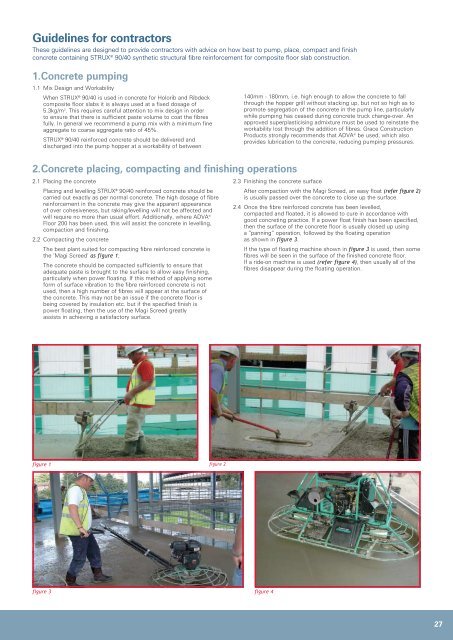Create successful ePaper yourself
Turn your PDF publications into a flip-book with our unique Google optimized e-Paper software.
Guidelines for contractors<br />
These guidelines are designed to provide contractors with advice on how best to pump, place, compact and finish<br />
concrete containing STRUX ® 90/40 synthetic structural fibre reinforcement for composite floor slab construction.<br />
1. Concrete pumping<br />
1.1 Mix Design and Workability<br />
When STRUX ® 90/40 is used in concrete for Holorib and Ribdeck<br />
composite floor slabs it is always used at a fixed dosage of<br />
5.3kg/m 3 . This requires careful attention to mix design in order<br />
to ensure that there is sufficient paste volume to coat the fibres<br />
fully. In general we recommend a pump mix with a minimum fine<br />
aggregate to coarse aggregate ratio of 45%.<br />
STRUX ® 90/40 reinforced concrete should be delivered and<br />
discharged into the pump hopper at a workability of between<br />
2. Concrete placing, compacting and finishing operations<br />
2.1 Placing the concrete<br />
Placing and levelling STRUX ® 90/40 reinforced concrete should be<br />
carried out exactly as per normal concrete. The high dosage of fibre<br />
reinforcement in the concrete may give the apparent appearance<br />
of over cohesiveness, but raking/levelling will not be affected and<br />
will require no more than usual effort. Additionally, where ADVA ®<br />
Floor 200 has been used, this will assist the concrete in levelling,<br />
compaction and finishing.<br />
2.2 Compacting the concrete<br />
The best plant suited for compacting fibre reinforced concrete is<br />
the ‘Magi Screed’ as figure 1;<br />
The concrete should be compacted sufficiently to ensure that<br />
adequate paste is brought to the surface to allow easy finishing,<br />
particularly when power floating. If this method of applying some<br />
form of surface vibration to the fibre reinforced concrete is not<br />
used, then a high number of fibres will appear at the surface of<br />
the concrete. This may not be an issue if the concrete floor is<br />
being covered by insulation etc. but if the specified finish is<br />
power floating, then the use of the Magi Screed greatly<br />
assists in achieving a satisfactory surface.<br />
figure 1 figure 2<br />
figure 3<br />
140mm - 180mm, i.e. high enough to allow the concrete to fall<br />
through the hopper grill without stacking up, but not so high as to<br />
promote segregation of the concrete in the pump line, particularly<br />
while pumping has ceased during concrete truck change-over. An<br />
approved superplasticising admixture must be used to reinstate the<br />
workability lost through the addition of fibres. Grace Construction<br />
Products strongly recommends that ADVA ® be used, which also<br />
provides lubrication to the concrete, reducing pumping pressures.<br />
2.3 Finishing the concrete surface<br />
After compaction with the Magi Screed, an easy float (refer figure 2)<br />
is usually passed over the concrete to close up the surface.<br />
2.4 Once the fibre reinforced concrete has been levelled,<br />
compacted and floated, it is allowed to cure in accordance with<br />
good concreting practice. If a power float finish has been specified,<br />
then the surface of the concrete floor is usually closed up using<br />
a “panning” operation, followed by the floating operation<br />
as shown in figure 3.<br />
If the type of floating machine shown in figure 3 is used, then some<br />
fibres will be seen in the surface of the finished concrete floor.<br />
If a ride-on machine is used (refer figure 4), then usually all of the<br />
fibres disappear during the floating operation.<br />
figure 4<br />
27


